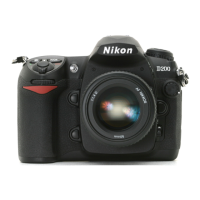✦ PC/X flash connector. Remove
the cover to access a PC/X-sync
electronic flash connector for use
with non-dedicated flash units,
such as studio flash.
✦ 10-pin remote connector. Remove
the protective cover to use the ter-
minal with accessories like the
Nikon MC-22, MC-30, or MC-36
remote cords (which function like
the cable releases used with non-
electronic film cameras), as well as
other accessories, including infrared
remotes, time-lapse photography
devices, Global Positioning System
accessories (to record latitude, lon-
gitude, and time with each still
image), and cables that connect two
cameras for simultaneous operation.
✦ AC power/AV connector/USB
port connector covers. On the
side of the camera, you’ll see two
rubber covers that protect the
D200’s other external connectors.
These include the AC power con-
nector, which can operate the cam-
era without batteries (for, say,
studio work or time-lapse photog-
raphy). (The D200 uses the same
EH-6 AC adapter as the D2X and
D2Hs.) Just above the AC power
connector is an AV plug that you
can use to link the D200 to an
external monitor for viewing pic-
tures or menus. The bottom-most
connector accepts the USB cable,
which enables you to transfer pic-
tures directly from the camera to
your computer, and also lets you
control the camera’s functions
using the Nikon Capture software.
On Top
The top surface of the D200 has its own set
of controls, shown in figure 1.5. In addition,
a bird’s-eye view provides the best perspec-
tive of some of the controls on the lens. I’ve
divided these controls into a pair of bite-
sized color-coded pieces, too, with the red
box assigned to the lens controls, and green
box to the camera-body controls.
16 Part I ✦ Using the Nikon D200
Flip-up electronic flash/Speedlight
Flash sync mode
Flash exposure compensation
Flash lock release
1.4 Pressing the flash multi-function
button (flash exposure compensation
button) pops up the built-in electronic
flash, ready for use.
1.5 The top view of the D200 and the
18mm–70mm kit lens.
06_037482 ch01.qxp 9/18/06 1:37 PM Page 16

